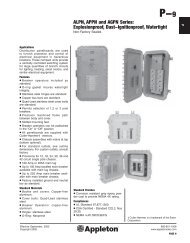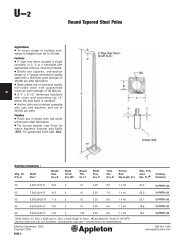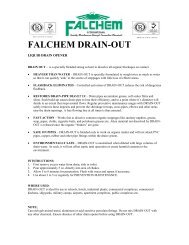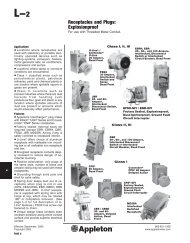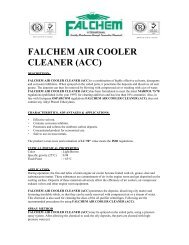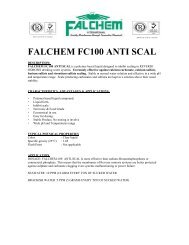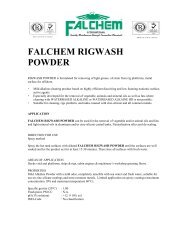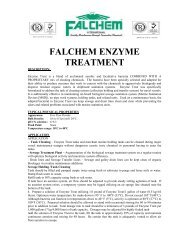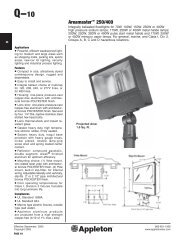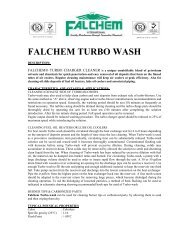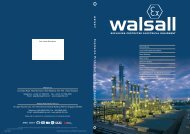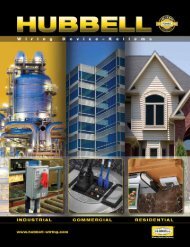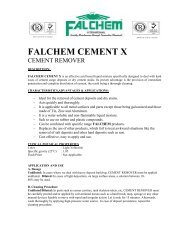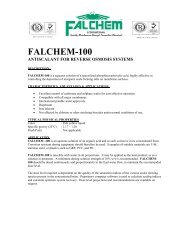Untitled
Untitled
Untitled
Create successful ePaper yourself
Turn your PDF publications into a flip-book with our unique Google optimized e-Paper software.
Technical Information<br />
7.11<br />
18 Glass and stone processing<br />
18.1 Stone cutting, stone grinding R11<br />
18.2 Glass shaping of hollow glass ware, container ware,<br />
glass for building purposes<br />
R11<br />
18.3 Grinding areas for hollow glass ware, flat glass R11<br />
18.4 Insulating glass manufacture; handling of drying agents R11 V6<br />
18.5 Packaging, shipping of flat glass; handling of anti-adhesive agents R11 V6<br />
18.6 Etching and acid polishing facilities for glass R11<br />
19 Cast concrete factories<br />
19.1 Concrete washing areas R11<br />
20 Storage areas<br />
20.1 Storage areas for oils and fats R12 V6<br />
20.2 Storage areas for packed food R10<br />
20.3 Outdoor storage areas R11 (or R10 V4)<br />
21 Chemical and thermal treatment of iron and metal<br />
21.1 Pickling plants R12<br />
21.2 Hardening shops R12<br />
21.3 Laboratory rooms R11<br />
22 Metal processing, metal workshops<br />
22.1 Galvanizing shops R12<br />
22.2 Grey cast iron processing R11 V4<br />
22.3 Mechanical processing areas (turnery, milling shop),<br />
punching room, pressroom, drawing shop (pipes, wires)<br />
and areas exposed to increased stress by oil and lubricants R11 V4<br />
22.4 Parts cleaning areas, exhaust steam areas R12<br />
23 Vehicle repair workshops<br />
23.1 Repair and servicing bays R11<br />
23.2 Working and inspection pits R12 V4<br />
23.3 Car washing halls, washing areas R11 V4<br />
24 Aircraft repair workshops<br />
24.1 Aircraft hangars R11<br />
24.2 Repair hangars R12<br />
24.3 Washing halls R11 V4<br />
*) For floors in wet areas walked on barefoot, see the GUV information “Floor coverings<br />
in wet barefoot areas” (GUV-I 8527, previous GUV 26.17).<br />
**) Entrance areas according to number 0.1 are all areas with direct access from<br />
outside and in which moisture from outside can be brought. For adjoining areas or<br />
other rooms with large surfaces, paragraph 3.4 of this Code of practice has to be<br />
considered.<br />
***) Stairs according to number 0.3 are those possibly exposed to moisture<br />
brought in from outside. For adjoining areas, paragraph 3.4 of this Code of practice<br />
has to be observed.<br />
****) If the same floor covering was laid in all areas, the displacement space can be<br />
lowered down to V4 after a risk analysis (taking into consideration the cleaning<br />
method, the working processes and the quantity of slippery substances on the<br />
floor).<br />
*****) The pedestrian areas which are not subject to a risk of slipping because of<br />
weather influences such as driving rain or moisture brought in.<br />
In connected work places with differing slip risks, where employees move from<br />
one work place to the other, the same floor covering of the higher valuation group<br />
should be used for the entire area.<br />
If floor coverings of different slip resistance are used in connected work rooms or<br />
areas, only floor coverings of two consecutive valuation groups should be used<br />
next to each other, e.g. valuation groups R10 and R11 or R11 and R12 etc. This<br />
also applies to corridors and stairs adjoining wet areas such as e.g. sanitary rooms.<br />
The floors must be even to avoid stumbling and pools of water. This can be<br />
achieved by letting the floors slope gently towards the floor drains. To facilitate<br />
cleaning it may be useful to use smooth, non-profiled floor coverings along the<br />
walls up to a distance of 15 cm, in corners and under machines which are firmly<br />
fixed to the floor.<br />
A rounded edge – carried out by a cove skirting between the walls and floor – is<br />
easier to clean than a rectangular edge.<br />
25 Sewage treatment plants<br />
25.1 Pump rooms R12<br />
25.2 Rooms for sludge draining facilities R12<br />
25.3 Rooms for screening equipment R12<br />
25.4 Stands of workplaces, scaffolds and maintenance platforms R12<br />
26 Fire brigade buildings<br />
26.1 Vehicle parking places R12<br />
26.2 Rooms for hose maintenance equipment R12<br />
27 Financial institutions<br />
27.1 Counter areas R9<br />
28 Parking areas<br />
28.1 Garages, car-parks not exposed<br />
to weather influences*****)<br />
R10<br />
28.2 Garages, car-parks exposed<br />
to weather influences R11 (or R10 V4)<br />
28.3 Open-air parking areas R11 (or R10 V4)<br />
29 Schools and kindergartens<br />
29.1 Entrance areas, corridors, assembly halls R9<br />
29.2 Class rooms, group rooms R9<br />
29.3 Stairs R9<br />
29.4 Toilets, washrooms R10<br />
29.5 Instructional kitchens in schools (also see no. 9) R10<br />
29.6 Kitchens in kindergartens (also see no. 9) R10<br />
29.7 Machine rooms for wood processing R10<br />
29.8 Special rooms for handicrafts R10<br />
29.9 Schoolyards R11 (or R10 V4)<br />
30 Plant traffic routes in outdoor areas<br />
30.1 Footpaths R11 (or R10 V4)<br />
30.2 Loading platforms<br />
30.2.1 covered R11 (or R10 V4)<br />
30.2.2 not covered R12 V4<br />
30.3 Sloping ramps (e.g. for wheel-chairs, loading platforms) R12<br />
30.4.1 Tank-up areas R12<br />
30.4.2 Tank-up areas, covered R11<br />
Technical Information<br />
Price list 2010, status December 2009



